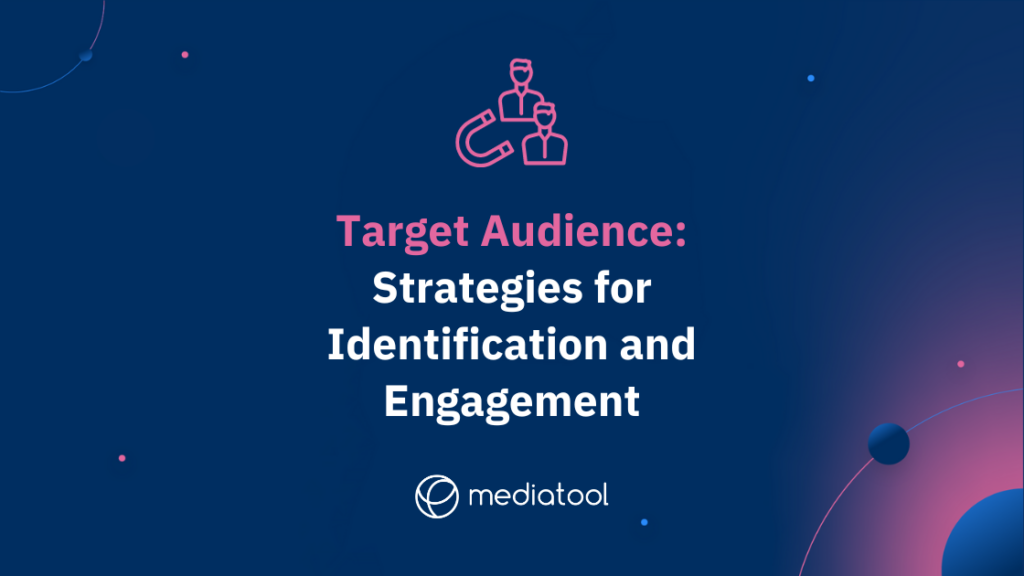When effort, time, and resources are invested in a project, it’s important to ensure they are directed toward the right people. If this doesn’t happen, businesses can find themselves in a situation where their efforts are not just unproductive but also misdirected, leading to wasted resources and diminished profits. Many businesses grapple with this issue, not realizing that the solution lies in identifying and catering to a specific target audience.
Understanding your target audience ensures that your message is not only heard but also well-received and acted upon. This article is a comprehensive guide on target audiences, providing insights and strategies to help you accurately identify and effectively communicate with the right group of potential customers.
What Is a Target Audience?
A target audience is a specific, defined group of prospects identified as the recipients of a particular marketing message. These individuals share specific characteristics, behaviors, or needs that align with the product or service being offered.
Recognizing a target audience enables businesses to predict how this group might behave or respond to different marketing strategies, ensuring that communication is tailored and relevant. This not only increases the chances of the message resonating but also fosters a sense of connection and understanding.
For businesses, establishing this connection is invaluable as it transcends transactional relationships, creating loyal customers and advocates for the brand. In essence, a well-understood and properly catered-to target audience forms the foundation of any successful marketing campaign or strategy, guiding product development, communication strategies, and resource allocation.
Target Markets Vs. Target Audiences
Understanding the distinction between target markets and target audiences is fundamental for effective marketing. A target market refers to the broader group of potential consumers who might be interested in your products or services.
It is a broad category of target consumers, encompassing everyone who falls under the likely customer umbrella. On the other hand, a target audience is a more specific and focused segment of this target market. This is the group that you are directly addressing and tailoring your marketing efforts toward.
The Broad Vs. The Specific
While the target market is broad and includes a general group of potential consumers, the target audience is much more specific, honed in on a niche group with particular characteristics or preferences.
The target market encompasses a wide range of potential consumers who might be interested in a company’s products or services. It’s a comprehensive category that includes anyone who could potentially buy from you. In contrast, a target audience is a narrower, more focused segment of the target market.
This group is specifically identified based on distinct characteristics like age, interests, or buying habits. By focusing on a target audience, businesses can develop marketing strategies that are directly tailored to the needs and preferences of a particular group, making their efforts more efficient and effective.
Size Matters
The target market is larger in scale, covering a wide array of individuals. The target audience, however, is smaller in size but is considered more valuable due to its higher receptiveness to your marketing message.
The target market’s large size includes a diverse mix of individuals with varying interests and needs. In contrast, the target audience is more compact and defined, comprising individuals more likely to engage with and respond to specific marketing messages.
This smaller group is valuable to businesses because their likelihood of being interested in the company’s products or services is higher, making marketing efforts more productive.
Message Crafting
Messages crafted for the target market are broad and inclusive, aiming to appeal to a wide audience. In contrast, messages for the target audience are more refined, personalized, and specific, designed to resonate deeply with that particular group.
When creating messages for the target market, the language and content are more general to cater to a diverse audience. However, when focusing on the target audience, the messaging becomes much more tailored. Businesses take the time to understand this group’s unique preferences, challenges, and desires.
As a result, the content created for them is highly personalized, increasing the chances of engagement and a positive response.
Resource Allocation
Resources for targeting the market are spread out, as there are many different preferences and needs to cater to. For the target audience, resources are more strategically allocated, with a focus on what appeals most to that specific group.
In targeting a broad market, businesses spread their resources across various channels and strategies to reach a diverse audience. However, when the focus shifts to a target audience, resource allocation becomes more strategic and concentrated.
Businesses invest in channels and tactics most likely to reach and influence this specific group, making the use of resources more efficient and the return on investment potentially higher.
Feedback and Adaptation
Feedback from the target market tends to be varied and general. From the target audience, feedback is specific, detailed, and highly valuable for making refinements and improvements.
The Difference Between a Target Audience and a Customer Persona

Have you ever felt incredibly connected to a character from your favorite TV show, as if you know them inside out? This distinction is similar to the one between a target audience and a customer persona. A target audience encompasses a broad group, while a customer persona represents a highly detailed profile of an individual within that group.
Depth of Detail
Target Audience: This is a broader category, focusing on shared characteristics within a large group. For example, “millennials interested in sustainable fashion” encompasses many individuals. Businesses may use social media analytics and research to identify the traits of these target audiences.
Customer Persona: This is a more nuanced and specific depiction, like creating a detailed character profile. An example could be “Mia, a 28-year-old graphic designer from Brooklyn who exclusively supports sustainable brands, enjoys morning yoga, and spends her weekends searching for vintage fashion treasures.” This persona is built from various data sources, including surveys and customer feedback.
Function & Utility
Target Audience: This concept helps shape overall marketing strategies and the direction of marketing campaigns. When planning at a high level, the target audience is essential. It’s about addressing a broad audience and understanding their general needs.
Customer Persona: This concept is more focused on audience examples and aids in creating content and developing products that appeal to a specific age group. It’s like having a direct line to what your potential customers might want or how they react to particular marketing efforts.
Creation Process
Target Audience: Identifying a target audience comes from broader market research, analyzing industry trends, and looking at data from current customers. It’s about understanding the general market and where your product or service fits in.
Customer Persona: Creating a customer persona requires a deeper dive into data, including conducting interviews and surveys and establishing feedback loops. It’s almost like writing a biography, where every small detail helps create a fuller picture.
Number and Variability
Target Audience: A business might have multiple target audiences depending on its range of products or services. For instance, a fashion brand’s target audiences could include “eco-conscious millennials” and other groups of “baby boomers interested in comfort.”
Customer Persona: Within each target audience, you could create multiple customer personas to represent different audience segments. So, for the “eco-conscious millennials” target audience, you might have both Mia, the graphic designer, and another persona like Jake, a vegan chef who is passionate about sustainable living.
Evolving Nature
Target Audience: Target audiences can stay relatively consistent over time, as they are based on broader traits and trends. For instance, the inclination for millennials to prefer sustainable fashion is a trend that might remain stable over several years.
Customer Persona: Customer personas need to be updated more frequently to stay relevant, as they are based on more specific and fleeting characteristics and behaviors. Keeping Mia’s profile up-to-date ensures continued engagement and relevance.
Real Vs. Representative
Target Audience: This refers to an actual group of people in the real world, such as all millennials interested in sustainable fashion. They are the broader audience that your marketing campaigns are trying to reach.
Customer Persona: This is a fictional character created to represent a segment of your target audience. While Mia isn’t a real person, her profile reflects the behaviors, preferences, and characteristics of a specific group of real people.
The Benefits of Finding Your Target Market

Efficiency with Resources
In any marketing campaign, zeroing in on your ideal target audience transforms your approach from a broad scatter-shot to a laser-focused strategy, ensuring each marketing effort is a direct hit. This precision reduces wasteful spending of your advertising budget and maximizes the use of your resources, catering precisely to the needs and behaviors of your target audience.
Strengthened Brand Voice
By concentrating your marketing campaigns on a specific audience, you tailor your company’s message to resonate more deeply with your potential customers, leading to a more recognizable and reliable brand voice across all communication channels.
In the realm of B2B marketing, this is particularly pivotal, as a substantial 87% of B2B marketers deem it crucial to communicate in a way that truly resonates with their target audiences. This consistency in messaging strengthens your business’s relationship with its target audience, making your brand the go-to choice for that particular audience and enhancing your competitive advantage.
Higher Engagement Rates
Engaging with your target audience on various social media channels and platforms with content tailored to their preferences and pain points leads to higher engagement rates. This active engagement not only fosters a strong community around your business but also provides valuable insights into consumer behavior, helping to refine your marketing plans and product offerings.
Boosted Sales and ROI
Understanding the specific needs and preferences of customers in your target audience ensures that your product or service is aligned with their expectations, leading to increased sales and a better return on investment. This alignment not only satisfies your current customers but also attracts new customers, expanding your target audience and business.
Clearer Product Direction
Continuous feedback and social media analytics from your target audience provide key insights that steer your product or service development in the right direction, ensuring it meets the unique needs of your audience. This clarity in product direction not only satisfies your specific target audience but also gives your business a competitive edge in the market.
Enhanced Customer Loyalty
When your target audience feels understood and valued, they are more likely to remain loyal to your brand and become advocates for your business. Every day, nearly one in four individuals discuss their preferred products with friends and family, highlighting the power of personal recommendations. This loyalty not only solidifies your relationship with your existing target audience directly but also attracts new customers through positive word-of-mouth, further expanding your customer base.
Easier Expansion and Scaling
Having a strong foothold with a specific target market or audience makes it easier to identify and tap into new target markets and audience segments, enabling smoother business expansion and scaling. This strategic expansion is guided by the insights and understanding gained from your initial target audience, ensuring success in new ventures and continued business growth.
How to Find Your Target Audience
Initiating the Process: Understanding Your Target Audience
Diving into existing data is the initial step to uncovering your target audience. This involves analyzing sales and website activity through tools like Google Analytics and assessing your engagement with social followers on various social media platforms.
The goal is to pinpoint the characteristics of your current customers and recognize patterns that could lead you to a wider audience. This process is critical to ensure your marketing efforts are targeted and efficient, ultimately conserving your advertising budget.
Engaging with Surveys and Seeking Feedback
Surveys and feedback forms serve as direct communication channels to your target audience, providing valuable insights into their needs, preferences, and pain points. This information is crucial for tailoring your product or service and refining your marketing strategies to better suit your audience.
Conducting Competitor Analysis for Market Positioning
Analyzing what target market your competitors are focusing on can provide a competitive advantage. This process involves identifying their target audience, business and marketing efforts, which can offer valuable insights into potential customers you may have overlooked.
Creating Mock Personas for Clarity
Crafting fictional characters or buyer personas based on your findings helps visualize and understand the different segments and purchase intention of your target audience. This exercise aids in creating more personalized and effective marketing campaigns, ensuring you are not just reaching a wide audience but connecting with them on a more personal level.
Engaging and Interacting on Social Media Platforms
Utilizing social media channels for engagement is a vital component in understanding and connecting with your target audience. This not only enhances your social media presence but also provides an opportunity to gather social media analytics, offering a deeper insight into consumer behavior and preferences.
Testing and Refining Your Approach
Launching small, targeted marketing campaigns allows you to test different approaches and understand what resonates best with specific audience segments. This trial-and-error method is a practical way to refine your focus and improve your marketing plans.
Staying Updated with Market Trends
Keeping abreast of market trends through various channels such as industry journals, webinars, and forums ensures that your business stays relevant and your marketing strategies align with the evolving needs of your target audience.
Soliciting Continuous Feedback for Improvement
Regular interaction and feedback from your target audience provide an opportunity to adapt and evolve your strategies, ensuring they continue to meet the needs and expectations of your audience.
Understanding Your Target Audience: Insights and Profiles for Precision Marketing
Navigating through the landscape of marketing requires a deep understanding of who you are speaking to, what their specific needs are, and how your brand can fulfill those needs. This process begins with gaining target audience insights, a crucial step that enables marketing managers to craft messages that resonate directly with their intended demographic. A significant 82% of marketers emphasize that quality data on their target audience is crucial for success in their role.
However, interpreting this data to understand the current needs of the audience remains a significant challenge. In a 2022 survey among U.S. marketing decision-makers overseeing advertising strategies, 54 percent identified their primary challenge in reaching target audiences as interpreting customer data to grasp current needs.
To effectively find your target audience, you must focus on audience demographics, dissecting everything from age range and job titles to all the details that make up their daily lives and purchase decisions.
This level of specificity transforms your general marketing strategy into a laser-focused effort that speaks directly to each segment of your targeted audience.
Creating a target audience profile goes beyond just listing out demographic information. It involves understanding the whole audience – their likes, dislikes, preferences in content, their favorite radio stations or landing pages, and even their typical buying process. These details are vital for marketing managers who are tasked with developing a content strategy that not only appeals to different target audiences but also leads to conversions.
Examples of specific audience profiles range from college students looking for affordable and trendy fashion options to middle-aged professionals interested in educational content that enhances their skills. The key is to create content that addresses the particular needs of each audience segment, guiding them through the buying process with tailored messages and targeted marketing activities.
Engaging in email marketing, for example, allows you to reach different groups within your audience, sending personalized messages that speak directly to their unique interests and needs. This targeted approach ensures that your message is not lost in the noise, but instead lands precisely where it needs to, resulting in new customers who feel understood and valued.
For a more in-depth analysis, marketing managers can create target personas and detailed buyer persona profiles representing ideal customers within each target audience. These personas include all demographic details, interests, job titles, and any other pertinent information that paints a comprehensive picture of who the customer is.
Brands can utilize these personas to tailor their marketing activities, ensuring that every piece of content, every email, and every marketing campaign is aligned with the audience’s expectations and needs. This not only boosts the brand’s image but also enhances the relevance of the content, leading to a stronger connection with the audience.
Conclusion
Understanding your target audience isn’t just useful; it’s crucial. It’s about knowing who’s on the other side of the screen, what they want, and how you can give it to them. You’re not just throwing information out there and seeing what sticks. No, it’s more strategic than that. You’re crafting messages that hit home, that resonate.
This isn’t about using fancy corporate jargon or industry buzzwords. It’s about clear, straightforward talk. Think about it. When you know your audience, you can speak directly to them, addressing their needs and interests. That’s what keeps them coming back for more.
It’s not just about finding these folks once. It’s about keeping them engaged and building a relationship over time. Whether it’s through email marketing, social media interactions, or any other channel, the goal is the same. Connect, communicate, and deliver value.
It’s pretty straightforward. Know your audience, talk to them in a way that makes sense to them, and keep the lines of communication open. Do that, and you’re on the right track.





